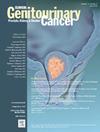在当代晚期尿路上皮癌治疗的时代,性别、种族和年龄的生存差异:现实世界的分析
IF 2.7
3区 医学
Q3 ONCOLOGY
引用次数: 0
摘要
回顾性数据显示,女性、少数民族和老年晚期尿路上皮癌(aUC)患者的生存率较低。然而,关于现代生存差异的数据仍然有限。方法本队列研究使用Flatiron Health的全国去识别电子健康记录(EHR)衍生数据库。纳入2017年1月至2024年5月期间接受aUC全身治疗的患者。提取基线特征、治疗史和临床结果。PFS和OS按性别(男性与女性)、种族(白人、黑人与亚洲/太平洋岛民[API])和诊断时年龄(>;65岁[y] vs.≤65岁),采用Kaplan-Meier对数秩分析和Cox比例风险模型。单变量比较采用独立样本t检验和卡方分析。假定值& lt;0.05认为有统计学意义。结果共检出aUC患者5142例。其中女性1419例(28%),男性575例(11%);在有种族记录的人中(n = 3492), 1%为API, 5%为黑人,14%为“其他”,80%为白人。PFS无差异(8.7 vs. 9.0个月[m], HR1.03;P = 0.82)或OS (13.2 vs 13.5 m;HR1.05, P = .31)。女性接受免疫检查点抑制剂(ICI)治疗的PFS较男性短(P = 0.002),但其他一线(1L)治疗的PFS较短。API患者的PFS相当(9.6 m vs. 8.9 m;HR0.91;P = 0.45),但更长的OS (28.5 vs. 14.1 m;HR0.56;P = 0.008)。黑人患者的PFS相当(7.9 vs 8.5;HR1.06;P = .81)和OS (11.5 vs. 14.1 m;HR1.32;P = 0.73) vs白人患者。病人在65 y的PFS较短,≤65 y (7.6 vs. 9.0 m;Hr1.14, p = 0.019);然而,老年患者的OS更长(16.5 m比12.8 m;HR0.80, P <;措施)。只有在1L ICI, OS在那些>;65 y与≤65 y相比(HR0.71;P = 0.021)结论在这个庞大的真实世界数据库中,女性aUC患者的PFS和OS与男性相当。API患者的OS优于White患者。病人在65岁以下患者的PFS较差,但OS较好。本文章由计算机程序翻译,如有差异,请以英文原文为准。
Survival Disparities by Sex, Race, and Age in the Era of Contemporary Advanced Urothelial Carcinoma Therapy: A Real-World Analysis
Introduction
Retrospective data suggest poorer survival for female, racial minority, and older advanced urothelial carcinoma (aUC) patients. However, data on survival disparities in the modern era remain limited.
Methods
This cohort study used Flatiron Health’s nationwide de-identified electronic health record (EHR)-derived database. Patients who initiated systemic therapy for aUC between January, 2017 and May, 2024 were included. Baseline characteristics, treatment history, and clinical outcomes were abstracted. PFS and OS were compared by sex (male vs. female), race (White, Black, vs. Asian/Pacific Islander [API]), and age at diagnosis (> 65 years [y] vs. ≤ 65 y), using Kaplan-Meier log-rank analysis and Cox proportional hazards models. Independent sample t-tests and chi-square analyses were used for univariate comparisons. P-values < .05 were considered statistically significant.
Results
A total of 5142 patients with aUC were identified. 1419 were (28%) female and 575 (11%) were > 65 y. Of those with recorded race (n = 3492), 1% were API, 5% Black, 14% categorized as “other,” and 80% White. There was no difference in PFS (8.7 vs. 9.0 months [m], HR1.03; P = .82) or OS (13.2 vs. 13.5 m; HR1.05, P = .31) between women and men. Women had shorter PFS to men on immune checkpoint inhibitors (ICI) (P = .002) but not with other first-line (1L) therapy. API patients had comparable PFS (9.6 vs. 8.9 m; HR0.91; P = .45) but longer OS (28.5 vs. 14.1 m; HR0.56; P = .008) compared to White patients. Black patients had comparable PFS (7.9 vs. 8.5; HR1.06; P = .81) and OS (11.5 vs. 14.1 m; HR1.32; P = .73) vs White patients. Patients > 65 y had shorter PFS to ≤ 65 y (7.6 vs. 9.0 m; HR1.14, P = .019); however, OS was longer in older patients (16.5 vs. 12.8 m; HR0.80, P < .001). Only on 1L ICI, OS was longer in those > 65 y compared to those ≤ 65 y (HR0.71; P = .021)
Conclusion
In this large real-world database, female aUC patients had comparable PFS and OS to males. API patients showed superior OS to White patients. Patients > 65 y had inferior PFS but superior OS to patients ≤ 65 y.
求助全文
通过发布文献求助,成功后即可免费获取论文全文。
去求助
来源期刊

Clinical genitourinary cancer
医学-泌尿学与肾脏学
CiteScore
5.20
自引率
6.20%
发文量
201
审稿时长
54 days
期刊介绍:
Clinical Genitourinary Cancer is a peer-reviewed journal that publishes original articles describing various aspects of clinical and translational research in genitourinary cancers. Clinical Genitourinary Cancer is devoted to articles on detection, diagnosis, prevention, and treatment of genitourinary cancers. The main emphasis is on recent scientific developments in all areas related to genitourinary malignancies. Specific areas of interest include clinical research and mechanistic approaches; drug sensitivity and resistance; gene and antisense therapy; pathology, markers, and prognostic indicators; chemoprevention strategies; multimodality therapy; and integration of various approaches.
 求助内容:
求助内容: 应助结果提醒方式:
应助结果提醒方式:


